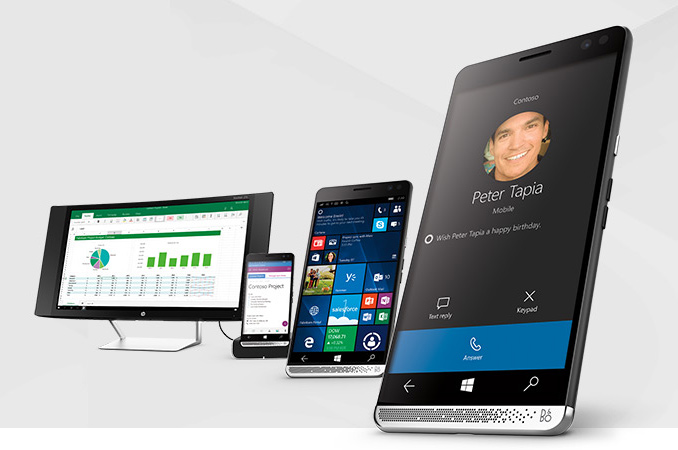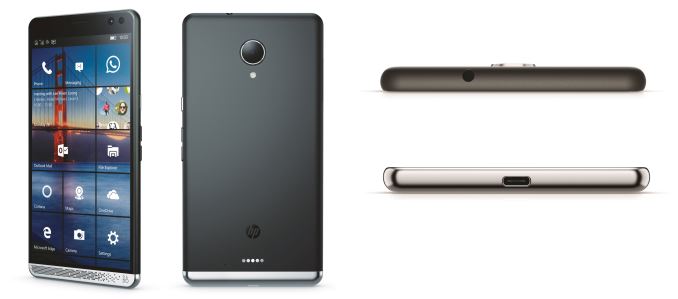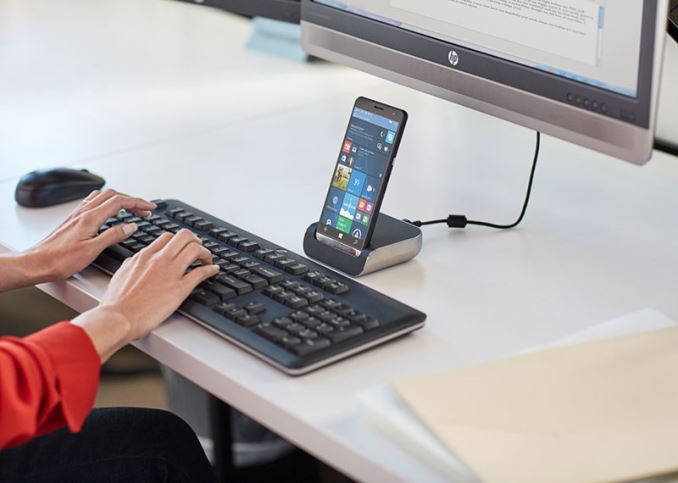HP’s Elite x3 Windows 10 Smartphone to Cost $699, Set to Be Available Worldwide
by Anton Shilov on July 21, 2016 11:00 AM EST- Posted in
- Smartphones
- HP
- Microsoft
- Windows 10 Mobile
- Continuum

When HP introduced its flagship Elite x3 phablet earlier this year at MWC, the smartphone made a very positive impression mostly because HP decided to make a bold move and create a Windows Continuum device aimed purely at the business professional on a company contract. It drew a little ire from some industry analysts, thinking that HP building a Windows phone would never see the light of day. To them it was a paper announcement, but this week shows that the Elite x3 is still alive and well, and coming to consumers and business users. What the company did not announce in February was its recommended price as well as countries, where it planned to make the product available. This weeks details show that the Elite x3 will hit the market in August and will be sold in 46 countries worldwide.
The HP Elite x3 smartphone is based on Qualcomm’s Snapdragon 820 SoC, as well as Microsoft’s Windows 10 Mobile OS. The device is equipped a 5.96” AMOLED display and comes with 64 MB of eMMC 5.1 NAND flash storage, 4 GB of LPDDR4 RAM as well as all the necessary connectivity features, including 4G/LTE, 802.11ac Wi-Fi, Bluetooth 4.0 and a USB Type-C connector. Developed specifically for enterprise and business users, who value security, the device is FIPS 140-2 certified and features Secure Boot (with iris and fingerprint scanners), full disk encryption with a 256-bit key, fTPM 2.0, and so on.
| HP Elite x3 | |
| SoC | Qualcomm Snapdragon 820 2x Kryo @ 2.15 GHz 2x Kryo @ 1.59 GHz Adreno 530 |
| RAM/NAND | 4 GB LPDDR4 RAM, 64 GB eMMC 5.1 NAND microSD 'up to 2 TB' |
| Display | 5.96-inch, 2560x1440 AMOLED (494 PPI) Corning Gorilla Glass 4 |
| Network | X12 Cat 12/13 LTE-A Single Nano-SIM or Dual Nano-SIM Models Micro-SD Shared with Nano-SIM |
| Dimensions | 161.8 x 83.5 x 7.8 (mm) 6.36 x 3.29 x 0.31 (in) |
| Weight | 195 grams 0.43 lb / 6.88 oz |
| Rear Camera | 16 MP, LED Flash |
| Front Camera | 8 MP wide angle, Iris Camera |
| Battery | 4150 mAh, 3.85 V, 15.98 Wh, PMA and Qi charging |
| OS | Windows 10 Mobile |
| Connectivity | Intel AC-7260AN WiFi (2x2 802.11ac + BT 4.0 LE) NFC, GPS USB 3.0 Type-C |
| Additional | Windows Hello (Iris and Fingerprint), FIPS 140-2, fTPM 2.0 128-bit Unified encryption, 256-bit full disk Disaster recovery Protection Win10 includes 128-bit BitLocker and Enterprise Grade VPN Bang&Olufsen Sound 3x Noise-Cancelling Microphones |
| Water/Dust Proof Certification | IP 67 MIL-STD 810G (salt/fog/humidity/shock/thermal) |
While the internal specifications of the HP Elite x3 are impressive, the company does not position the device as just its flagship smartphone. HP believes that there are enterprise customers interested in using one device for multiple workloads and in various situations by taking advantage of Microsoft’s Continuum technology, which allows you to run your phone as a desktop PC. To support such clients, HP intends to offer a special dock (with an Ethernet adapter, DisplayPort USB connectors, etc.) that can work with desktop displays as well as keyboards. When purchased from the HP online store, the dock should come as standard. In addition, the company plans to sell the Mobile Extender laptop, which does not have its own processor or storage, but relies on the Elite x3. The Mobile Extender has a 12.5” display (with 1920x1080 resolution), USB-C ports, speakers as well as a spill-resistant keyboard with a drain and backlighting.
Current competition, at least in the Continuum space, comes from Acer's Liquid Jade Primo which was demoed at MWC and quietly shipped several days ago, and the Lumia 950.
According to Engadget, which cites a representative of HP, the phablet itself will cost $699 in the U.S. and $799 when acquired with a dock, starting from August 29. Slashgear claims that the Elite x3 will cost €863 in the Netherlands and 8,624 SEK in Sweden. Unfortunately, the price of the Mobile Extender is still unknown.
Sources: Engadget, Slashgear, HP Netherlands, HP Sweden.














67 Comments
View All Comments
nikon133 - Thursday, July 21, 2016 - link
Yep. This can replace thin client quite nicely, in both desktop (dock) and laptop form... and still of use when RDS is not possible. Email, calendar, contacts, basic MS Office features... will work.And then, security icing... TPM, encryption, iris scanner... we have some reasonably large customers who are quite aware, even obsessed with these things.
It could do well. Don't know if it will, but it could. And since they failed to address consumer market, playing on Microsoft's strongest card - enterprise presence - makes sense. If they manage to establish some territory there, spreading to consumers segment (v.2) could turn out to be a bit easier.
inighthawki - Friday, July 22, 2016 - link
I actually tried just this not too long ago. I played with the continuum feature of a lumia 950 and used the new remote desktop app to connect to my work machine. Worked fairly well all things considered. I wouldn't have known that I was on a phone if I wasn't the one who hooked it up.unuspromulti - Thursday, July 21, 2016 - link
The X3 and HP Workspace which they'll be selling with it to businesses will use Citrix to provide access to virtual desktops, x86 applications etc.10basetom - Thursday, July 21, 2016 - link
I wonder why they didn't use UFS 2.0 storage like most every other SD820 device, unless that's a typo.phoenix_rizzen - Thursday, July 21, 2016 - link
Yeah. It's nice that it includes 64 GB of storage by default, but to not use at least UFS 1.0 (UFS 2.0 is out already) seems odd. eMMC in a workhorse device seems very limiting.4 GB of RAM is a nice start. I haven't played with mobile Windows since the WinCE days, so not sure how heavy the apps are, but is that enough if you're going to be multi-tasking when docked?
BedfordTim - Thursday, July 21, 2016 - link
As an indicator, even the Snapdragon 808 in my 950 is noticeably faster than my Atom tablet.nikon133 - Thursday, July 21, 2016 - link
Not too heavy. I'm using 1GB Lumia 830 as my work phone. Native apps (Email etc) and mobile MS Office do very well. Skype for Business is a bit slow to start, but once open, also works fine.extide - Saturday, July 23, 2016 - link
It IS at least eMMC 5.1, which is pretty decent. Yeah, UFS would definitely be better but once we got to eMMC v5.0 it was pretty decent -- the older eMMC 4.51 and below really sucks (cough, Atom, cough)HomeworldFound - Thursday, July 21, 2016 - link
"HP’s Elite x3 Windows 10 Smartphone to Cost $699, Set to Be Available Worldwide"Why?
damianrobertjones - Thursday, July 21, 2016 - link
I own a 950. I've owned a 950xl. Still own a 1020 for mild camera duty.When I look at this phone, which has reasonable specs, I simply see zero reasons for it to succeed at all. Continuum is nice, has a place within business, but why would this sell when staff just want something shiny to 'think' that they're cool?